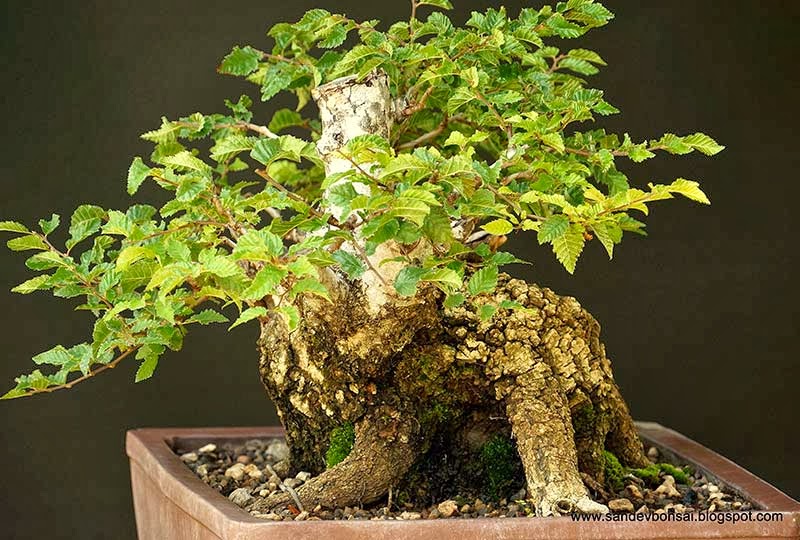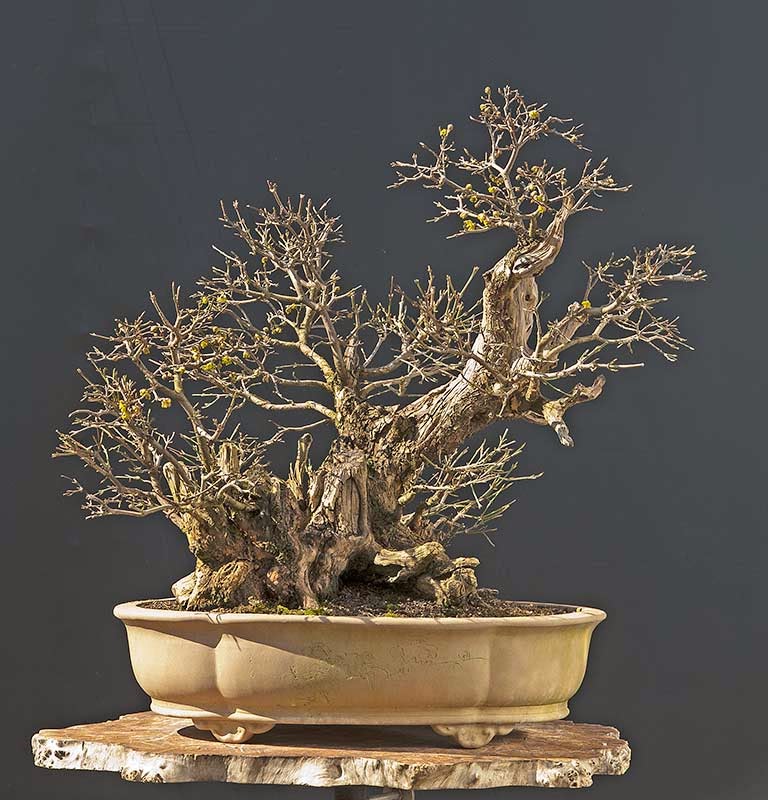The
Fairy Tale Bonsai Style (FTS)
by
Walter Pall
www.walter-pall.de
When
the International Bonsai Academy was at Sebastijan Sandev's place in
summer of 2o13 Sebastijan and I noticed that our ideas about styling
some trees were so far away from standard bonsai that we better call
it something else.
This
is how this all came abut:
"And
Sarah and John left their home in the afternoon because their mother
had told them that she could not feed them anymore and would sell
them to the rich farmers who would keep them like slaves. So the
children walked away into the woods holding their hands. They went
deeper and deeper into the forest and became quite afraid. It was
getting dark and the forest made it even darker. The children felt
without protection against all the wild animals and the ghosts and
the evil ones. They became very tired and finally saw this enormous
tree from far away. They were scared of the size, the mighty trunk
and the branches which were so thick like other trees and moved into
all directions like an octopus. They almost did not dare to get
closer. But since they had no choice they finally arrived at the
tree, which was even mightier than it had looked before. And they
crawled over the enormous roots and found this crevice in the trunk
which was large enough for both of them to enter. There they felt
safe and fell asleep. Then at midnight they woke up because the tree
spoke in a deep, gentle voice to them and asked them to crawl out. He
wanted to show them the forest and introduce them to all the animals
and to the other trees. And Sarah and Joe knew they were in a save
place and loved the tree. From then on trees meant something very
special to them."
This
is the trees that we try to create. It has not much to do with what
bonsai normally is other than that it is in a container, often not
even in a pot. It is mighty, spooky, grotesque, appearing monstrous
but being very warm and friendly, a tree that it so ugly that it is
beautiful again. He does not know that he is ugly, and he does not
care. Much more important is friendship and shelter for many. It is a
giving tree, a very soft core in a very hard shell.
How
does one go about creating tree in the FTS? First the material is
most important. It does not make sense in general to force whatever
form and style one is determined to create onto any piece of
material. The tree will tell you what it wants to become. What one
gets as bonsai material in general is not suitable for this kind of
style, it usually is suitable to become a standard bonsai. But the
'impossible' material, the monstrous collected tree which has so many
options but not a single 'good' one, the last dog, they can well be
good material for the FTS. One of the great advantages of this style
actually is that otherwise worthless material can be used for great
results. But this is not the real reason to work in this style. Some
will spread the word though that it is and we should ignore them.
They won't get it, anyway. There must be something in this chaotic
tree that you see which makes some sense. But sense in a fairy tale
way and not in a bonsai way. It can be a monstrous nebari, or very
strangely growing branches, or huge wounds which could be spooky
hollows.
Here some bonsai in the
FTS:
What's
the difference between the FTS and the naturalistic Style? First
let's see what they have in common. Both are controversial. This is a
given if something threatens the bonsai establishment. Both are here
since a long time already, but hardly noticed. The Chinese have done
naturalistic and fairy tale trees since a very long time. Both seem
to be easy, but are more difficult to do well than a so called
classical bonsai in the neoclassical bonsai style. Both are striving
to create a tree and absolutely not a typical bonsai. Both want to
give the tree a soul so that it can speak.
Now
the differences. While in the naturalistic style one usually tries to
create something beautiful this is not the object in the FTS. There
one tries to create something, impressive, unique, dominating in a
nice way.
This
all is in the very beginning and there will be many more examples.
This is only to start the discussions.
Here
some more images of trees in nature that could be the model for us:









































Fairy Tale Bonsai - pushing the bounds of the bonsai artists' imagination.
ReplyDeleteInitially I was perplexed by this style, but I'm coming around to it. With sufficient ramification, these trees portrait an ancient character, reminiscent of something out of the Lord of the Rings' Fangorn Forest. I envision a tree of this style in a worn and rugged wooden pot, like driftwood on a beach. To me, a tree with this much character just doesn't fit in a clean-cut bonsai pot.
Keep up the good work Walter,
-Kirk @ www.localbonsai.com
Dear Walter
ReplyDeleteI have read ALL the articles on the blog now; this means the ones in a language that I can understand...
One thing I keep asking myself: why are we keeping the word BONSAI?
The species we use can be bound to the place where we live, the way we give them a FORM is also related to this. Why still use a word that is so clearly Japanese? It might be a big part of all the controverse about styles and forms. To illustrate this in an absurd way: a quercus robur can never be a bonsai. It can be a POTTED TREE, a ARBRE EN POT, a BAUM IN EIN POT, a BOOM IN EEN POT, but never a BONSAI...
After seeing your Mugo pine 56 I had to ponder again these styling definitions of yours. I would see the naturalistic style somehow being at the edge of more accepted "mainstream bonsai", featuring natural forms that are not common enough to be accepted as "proper" bonsai. Thus the naturalistic style seems to slowly feed or inspire "mainstream" bonsai with natural forms, features and some aesthetic ideas that have previously been neglected or seen too outrageous. This idea it is somehow hidden in the pre-modern motto of bonsai: "make your bonsai look like a tree" otherwise said: "art imitates nature".
ReplyDeleteThen this fairy tale style appears to me not just controversial but merely contradictory to what we have been used to see in a pot. Just as modern art has detached itself from aesthetics - which is is considered as just one means of expression - here you say that FTS is not focused on it either; at least not as much as the naturalistic style. Therefore in FTS there is a greater freedom of expression as it is (more) detached from the culture dependent bonsai-rules. And i would also see it inspiring and reshaping the naturalistic style on its turn as well.
However, I would think that the interesting aspect about FTS is still the way it treats aesthetics. This is because i do not think that bonsai art is on its way to loosing natural forms as its main reference (say that we would start to make Chinese letter forms or just abstract "unnatural" compositions from small living trees) but (to me at least) the joy and the clue in bonsai is in this play between planned, artificial aspects and seemingly coincidental natural aspects. The FTS opens a new opportunities in this direction without actually discarding aesthetics. It also highlights our, sometimes childish manner to judge nature according to our own preconceived ideas.
Romanticism seems to be a significant element in FTS and that´s just wonderful. The fairy tales themselves are often romantic as well, but often also terrible, especially the older ones. Romanticism is about the soul, about being alive just as robust and just as mysterious as the life itself. Could we say that an essential method of expression in a FTS bonsai is to distract the viewer out of ordinary bonsai and aesthetic patterns and thus open him/her for a new unforeseen reality?
-infillion